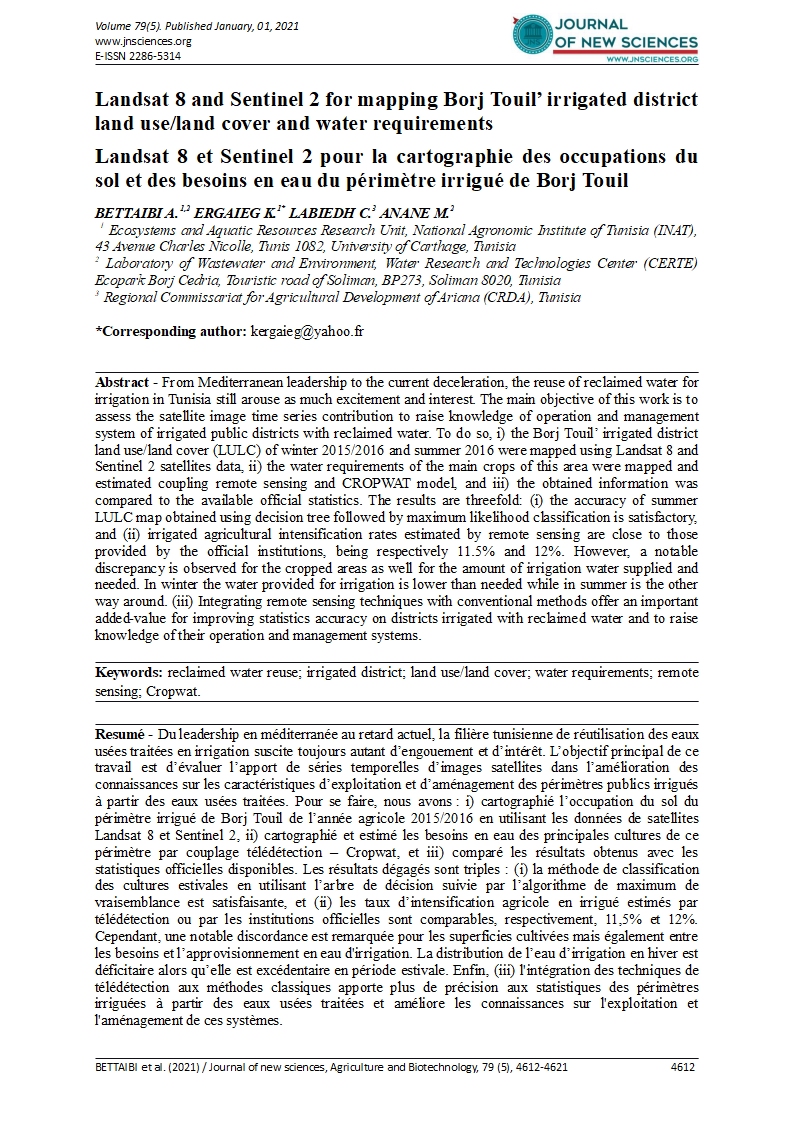

- Category: Volume 79
- Hits: 7575
Landsat 8 and Sentinel 2 for mapping Borj Touil’ irrigated district land use/land cover and water requirements
Landsat 8 and Sentinel 2 for mapping Borj Touil’ irrigated district land use/land cover and water requirements
Landsat 8 et Sentinel 2 pour la cartographie des occupations du sol et des besoins en eau du périmètre irrigué de Borj Touil
ERGAIEG K.1
LABIEDH C.3
ANANE M.2
1 Ecosystems and Aquatic Resources Research Unit, National Agronomic Institute of Tunisia (INAT), 43 Avenue Charles Nicolle, Tunis 1082, University of Carthage, Tunisia
2 Laboratory of Wastewater and Environment, Water Research and Technologies Center (CERTE) Ecopark Borj Cedria, Touristic road of Soliman, BP273, Soliman 8020, Tunisia
3 Regional Commissariat for Agricultural Development of Ariana (CRDA), Tunisia
Abstract - From Mediterranean leadership to the current deceleration, the reuse of reclaimed water for irrigation in Tunisia still arouse as much excitement and interest. The main objective of this work is to assess the satellite image time series contribution to raise knowledge of operation and management system of irrigated public districts with reclaimed water. To do so, i) the Borj Touil’ irrigated district land use/land cover (LULC) of winter 2015/2016 and summer 2016 were mapped using Landsat 8 and Sentinel 2 satellites data, ii) the water requirements of the main crops of this area were mapped and estimated coupling remote sensing and CROPWAT model, and iii) the obtained information was compared to the available official statistics. The results are threefold: (i) the accuracy of summer LULC map obtained using decision tree followed by maximum likelihood classification is satisfactory, and (ii) irrigated agricultural intensification rates estimated by remote sensing are close to those provided by the official institutions, being respectively 11.5% and 12%. However, a notable discrepancy is observed for the cropped areas as well for the amount of irrigation water supplied and needed. In winter the water provided for irrigation is lower than needed while in summer is the other way around. (iii) Integrating remote sensing techniques with conventional methods offer an important added-value for improving statistics accuracy on districts irrigated with reclaimed water and to raise knowledge of their operation and management systems.
Keywords: reclaimed water reuse; irrigated district; land use/land cover; water requirements; remote sensing; Cropwat.
Resumé - Du leadership en méditerranée au retard actuel, la filière tunisienne de réutilisation des eaux usées traitées en irrigation suscite toujours autant d’engouement et d’intérêt. L’objectif principal de ce travail est d’évaluer l’apport de séries temporelles d’images satellites dans l’amélioration des connaissances sur les caractéristiques d’exploitation et d’aménagement des périmètres publics irrigués à partir des eaux usées traitées. Pour se faire, nous avons : i) cartographié l’occupation du sol du périmètre irrigué de Borj Touil de l’année agricole 2015/2016 en utilisant les données de satellites Landsat 8 et Sentinel 2, ii) cartographié et estimé les besoins en eau des principales cultures de ce périmètre par couplage télédétection – Cropwat, et iii) comparé les résultats obtenus avec les statistiques officielles disponibles. Les résultats dégagés sont triples : (i) la méthode de classification des cultures estivales en utilisant l’arbre de décision suivie par l’algorithme de maximum de vraisemblance est satisfaisante, et (ii) les taux d’intensification agricole en irrigué estimés par télédétection ou par les institutions officielles sont comparables, respectivement, 11,5% et 12%. Cependant, une notable discordance est remarquée pour les superficies cultivées mais également entre les besoins et l’approvisionnement en eau d'irrigation. La distribution de l’eau d’irrigation en hiver est déficitaire alors qu’elle est excédentaire en période estivale. Enfin, (iii) l'intégration des techniques de télédétection aux méthodes classiques apporte plus de précision aux statistiques des périmètres irriguées à partir des eaux usées traitées et améliore les connaissances sur l'exploitation et l'aménagement de ces systèmes.
Mots-clés : réutilisation des eaux usées ; périmètre irrigué; occupation du sol ; besoins en eau ; télédétection ; Cropwat.

